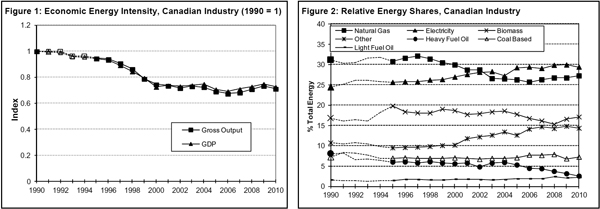Vancouver, BC: Even though the economic value of Canadian manufacturing output increased significantly in 2010, the intensity with which it used energy and its rate of emissions was declining. This is part of a long term trend that is not well-known in Canada: Although the economy as a whole has been consuming more and more energy, manufacturing has been getting more efficient and switching to cleaner sources of energy.
 2010 was in fact a bit of an exception to this general trend: “After showing a general decline since the peak of 2004, consumption of energy in the manufacturing sector rose in 2010 by 3.2% over 2009,” says CIEEDAC, the Canadian Industrial Energy End-use Data and Analysis Centre. “Even so, consumption is still 9% less than that of 1990 (still considered by some to be the baseline comparison year) and is still 18% below 2004 levels. As expected, fuel-based GHG emissions increased by nearly 4%; they are still more than 20% below 1990 emissions. Like consumption and emissions, GDP also increased by 7%, a rate high enough to show a decline in both energy and emissions intensity.”
2010 was in fact a bit of an exception to this general trend: “After showing a general decline since the peak of 2004, consumption of energy in the manufacturing sector rose in 2010 by 3.2% over 2009,” says CIEEDAC, the Canadian Industrial Energy End-use Data and Analysis Centre. “Even so, consumption is still 9% less than that of 1990 (still considered by some to be the baseline comparison year) and is still 18% below 2004 levels. As expected, fuel-based GHG emissions increased by nearly 4%; they are still more than 20% below 1990 emissions. Like consumption and emissions, GDP also increased by 7%, a rate high enough to show a decline in both energy and emissions intensity.”
CIEEDAC has been collecting data on industrial energy consumption patterns for many years and has assembled one of the most authoritative databases in the field. They have often observed that if one were looking at Canadian manufacturing industry alone, it is apparent that Canada would have had no difficulty at all in meeting the emission reduction targets originally agreed to when it first signed the Kyoto protocol. It observes that, “With the increase in the consumption of fossil fuels (including increased shares of coal-based fuels in 2010, see Fig. 2), GHG emissions from combustion in Canadian industry as defined in the ICE data (i.e., manufacturing industries) increased 4% from last year to a level 20% below 1990, well below the erstwhile important Kyoto target of 6% reduction from 1990 levels!”
CIEEDAC continues: “We see the shift toward electricity leveling off; its market share has been hovering around 30% since 2005. It currently has the greatest market share of all energy carriers in industry.”
